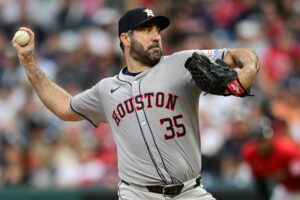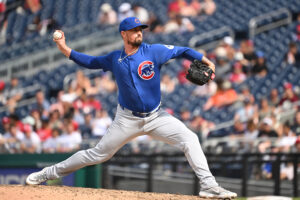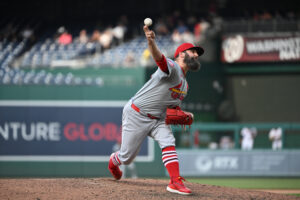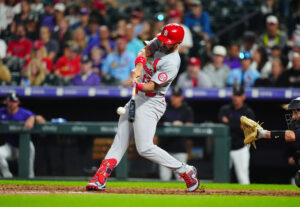MLB and MLB Players Association Reportedly Come to Terms on a 60-Game Season
Tuesday afternoon, the MLB Players Association formally accepted a deal with the MLB to start the 2020 season after rejecting Tuesday’s proposal. Jeff Passan of ESPN was the first source with the news.
The Major League Baseball Players Association has agreed to report to training camps by July 1 and play a 60-game season, sources tell ESPN, but deal is not finalized yet.
One last health-and-safety hurdle to get over and Major League Baseball will be back a week from tomorrow.
— Jeff Passan (@JeffPassan) June 23, 2020
One of the major concerns Monday was if players would agree to report by July 1st or not. As Passan noted in his tweet, both sides have overcome that and it is part of this final agreement.
Additionally, as part of the March 26th agreement, Commissioner Rob Manfred had the ability to mandate a schedule. In all likelihood, the schedule would have ended up between 50-60 games, but Commissioner Manfred went to the top of that scale. Furthermore, with a 60-game schedule that will allow baseball to conclude the regular season by September 27th. That has been another sticking point throughout the course of the negotiation process.
Health and Safety Protocols
The news of both sides coming together and agreeing on something is a welcome sight. That’s especially true after the rigorous negotiation process that the MLB and MLB Players Association have involved each other in over the past few weeks. Once the agreement was reached, the only thing remaining was an agreement on the health and safety protocols.
Players wanted MLB to clearly list out the protocols that it is planning on using this season. Some of those protocols have already been speculated, while others are still in development.
Marly Rivera of ESPN hinted towards some of the potential protocols that could be instituted Monday night on Twitter.
https://twitter.com/MarlyRiveraESPN/status/1275244145712476160
Both the testing and temperature check part of the process will be important. When it comes to testing, MLB will likely request players to arrive ahead of July 1st to their home cities for testing. Additionally, temperature checks will be significant and done regularly. If a player’s temperature is above normal, further testing could be in store.
Beyond this, there are bound to be a host of other safety and health protocol measures taken. For example, one potential idea could mirror what the NBA has come up with. Under that idea, players wear a ring which checks temperature, heart rate, and other health factors that could show if someone has COVID-19.
Other Things We Know
With the approval of the deal itself and the health and safety protocols, now it’s a matter of listing out the other details. Here’s what else we know:
The schedule will follow a 60-game format, but will be divided up in a way to prevent travel as soon as possible. Jon Heyman tweeted out that information on Twitter.
Plan is for teams to play 40 games in division and 20 games interleague with their geographic counterpart (East vs. East, etc.) #MLB
— Jon Heyman (@JonHeyman) June 24, 2020
Additionally, there are changes coming for the Designated Hitter position as well. Bob Nightengale of USA Today had that angle of the story.
There will be a DH in the National League for the first time.
— Bob Nightengale (@BNightengale) June 24, 2020
For a long time, the universal DH has been an issue in the game of baseball. Now, under this agreement both leagues will utilize it. For some teams, it will be interesting to see how they manipulate their roster and how they utilize the position especially in the NL.
Beyond that, Bob Nightengale also reports that depending on the Coronavirus trends around the country, MLB could shift where certain teams play.
MLB has the right to relocate teams during the regular season to neutral sites for health and safety reasons, including the postseason
— Bob Nightengale (@BNightengale) June 24, 2020
As has been the case in recent weeks, certain states have experienced a spike in cases. States like California, Arizona, Texas, and Florida have seen cases dramatically increase. Therefore, as the season wears on and the pandemic continues to change, there could be changes in other states where a MLB team might play. Details are still being hammered out about how that will work. However, it’s fair to assume that the logistics of MLB this year will need to be extremely flexible.
Reported Changes to Size of Roster
Furthermore, the size of rosters utilized by teams is reportedly going to change this year as well. Bob Nightengale also had that report on Twitter.
Clubs will open the season with 30 players until the 15th day of the season, 28 players until the 28th day and then 26 for the duration. There will be no expanded roster in September.
— Bob Nightengale (@BNightengale) June 24, 2020
With various reports of potential taxi squads being utilized, this is another intriguing development. Teams might see a chance to give a young, high-upside prospect a chance on their big league roster. Additionally, a team might be able to use this to their advantage if they lack impact on their pitching staff or need an extra bat. Regardless, for National League teams it helps teams have the option of adding an additional pitcher with the 26th spot for the entire season.
Potential Trade Deadline Included
Finally, another reported part of the deal includes a Trade Deadline at the end of August. Joel Sherman of the New York Post had that detail on Twitter.
As part of plans agreed to at this point between MLB and the PA, there will be an 8/31 trade deadline. I do think being traded in a pandemic is particularly tough. Think about having to relocate yourself and maybe family under these circumstances.
— Joel Sherman (@Joelsherman1) June 23, 2020
Given the expanded nature of the playoffs (16 teams total), this is an interesting development. Come the end of August, most teams will have played about 35 games. Therefore, they have a very small window to decide what direction they want to go in. This could make things especially intriguing for teams looking to offload salary. Additionally, it could be interesting for teams with star players that might have been on the market previously.
For example, the Cleveland Indians will have to decide whether they should trade Francisco Lindor or not. Lindor is due to hit free agency in two years, but was reportedly on the trade market all of last offseason. Therefore, the Indians will have a small window to either decide to go for it or pull back and entertain offers for Lindor.
Additionally, with the coronavirus shutdown, there might be teams looking to offload money. For instance, the San Francisco Giants might see a prime opportunity to offload one of their big contracts prior to the reported August 31st Trade Deadline. If San Francisco has the opportunity to get younger, they would likely be more than open to making a deal.
Final Thoughts
In the end, the biggest news of the day is that baseball is back. Those words that diehard and casual baseball fans alike love to hear “Play Ball!” will once again ring around all thirty ballparks in the near future. Although, the scene will look much different with no fans likely in attendance and strict social distancing guidelines being implemented for players and coaches alike.
Main Image
Embed from Getty Images






